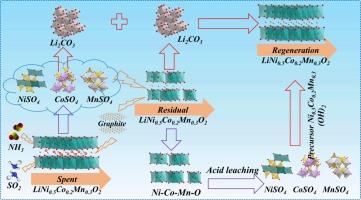Selective lithium extraction from spent LiNi0.5Co0.2Mn0.3O2/graphite mixed black powders and regeneration of single-crystal cathodes
IF 5.9
3区 工程技术
Q1 CHEMISTRY, MULTIDISCIPLINARY
Journal of Industrial and Engineering Chemistry
Pub Date : 2025-02-16
DOI:10.1016/j.jiec.2025.02.032
引用次数: 0
Abstract
Selective recovery of specific elements from spent lithium-ion batteries is essential for the sustainable development of finite resources. An approach to selectively extract lithium from the spent mixed black powder and regenerate single-crystal cathodes was proposed in this work. Firstly, (NH4)2SO4 was utilized to convert some of the spent LiNi0.5Co0.2Mn0.3O2(S-NCM523) in the mixed black powders to sulfates with different thermodynamic stability. With the further increase in temperature, the transition metal sulfates continued reaction with residual NCM523 (r-NCM523) generated water-soluble phase Li2SO4 and water-insoluble slag phase Ni-Co-Mn-O/graphite. It was worth mentioning that the graphite in the black powder reduced the Gibbs free energy of the sulfate roasting reaction under air atmosphere, which helped to reduce energy consumption. Then, 95.73 % of the Li was recovered by water-leaching, which was further converted into battery-grade Li2CO3. The precursor Ni0.5Co0.2Mn0.3(OH)2 was obtained by co-precipitation after acid leaching and filtration of the slag phase to remove residual graphite. Finally, the regeneration single-crystal NCM523 (RSC-NCM523) exhibited stable cycling performance compared with commercial single-crystal NCM523 (CSC-NCM523), which had an initial discharge specific capacity of 151.2 mAh g−1 at 1C and the capacity retention rate of 92.20 % after 100 cycles.

废LiNi0.5Co0.2Mn0.3O2/石墨混合黑粉选择性提锂及单晶阴极再生
从废旧锂离子电池中选择性回收特定元素对于有限资源的可持续发展至关重要。提出了一种从废混合黑粉中选择性提取锂并再生单晶阴极的方法。首先,利用(NH4)2SO4将混合黑粉中的部分废LiNi0.5Co0.2Mn0.3O2(S-NCM523)转化为具有不同热力学稳定性的硫酸盐。随着温度的进一步升高,过渡金属硫酸盐与残余的NCM523 (r-NCM523)继续反应生成水溶性相Li2SO4和水不溶性渣相Ni-Co-Mn-O/石墨。值得一提的是,黑粉中的石墨降低了硫酸盐在空气气氛下焙烧反应的吉布斯自由能,有助于降低能耗。然后,通过水浸回收95.73%的锂,进一步转化为电池级Li2CO3。通过酸浸和渣相过滤去除残余石墨,共沉淀法得到前驱体Ni0.5Co0.2Mn0.3(OH)2。最后,与商用单晶NCM523 (CSC-NCM523)相比,再生单晶NCM523 (RSC-NCM523)具有稳定的循环性能,在1C条件下的初始放电比容量为151.2 mAh g−1,循环100次后的容量保留率为92.20%。
本文章由计算机程序翻译,如有差异,请以英文原文为准。
求助全文
约1分钟内获得全文
求助全文
来源期刊
CiteScore
10.40
自引率
6.60%
发文量
639
审稿时长
29 days
期刊介绍:
Journal of Industrial and Engineering Chemistry is published monthly in English by the Korean Society of Industrial and Engineering Chemistry. JIEC brings together multidisciplinary interests in one journal and is to disseminate information on all aspects of research and development in industrial and engineering chemistry. Contributions in the form of research articles, short communications, notes and reviews are considered for publication. The editors welcome original contributions that have not been and are not to be published elsewhere. Instruction to authors and a manuscript submissions form are printed at the end of each issue. Bulk reprints of individual articles can be ordered. This publication is partially supported by Korea Research Foundation and the Korean Federation of Science and Technology Societies.

 求助内容:
求助内容: 应助结果提醒方式:
应助结果提醒方式:


